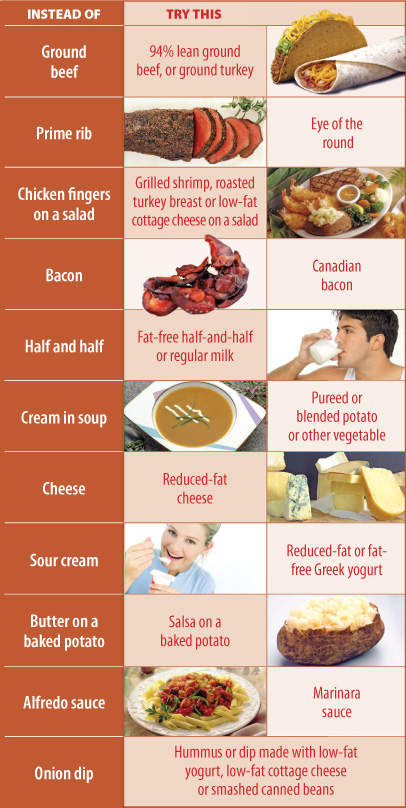
If you have been told you have high?cholesterol, you most likely want to take action. If you are already on medications?to control diabetes, you may be looking for natural options to avoid additional?medications. The good news is that?cholesterol, for many individuals, can be managed through diet and lifestyle changes. ?Although this approach takes some work,?in three to six months, you may be thrilled?with the changes in your cholesterol levels. Eat Your?Veggies One of the top ways to help reduce your?cholesterol levels is?by losing weight if?you are above an ideal body weight. Losing just as little?as 5-10% of your?total body weight can?result in improved?total cholesterol,?lower LDL cholesterol levels, and elevated HDL cholesterol.?To help with this,?focus on filling your?plate at each meal?at least halfway with vegetables.?Since vegetables are?loaded with fiber and?contain few calories,?filling your plate with?these allows you to take in less calories?while feeling full?and satisfied. And?they have another health bonus as well. Vegetables are rich in?soluble fiber, a fiber that helps to bind to cholesterol and flush?it from your body. So not only will eating more vegetables help?to shed pounds, but?it will help to further?reduce cholesterol as?well. When preparing vegetables, choose steamed options?over sautéed or?fried varieties to?prevent taking in?additional calories. Get Moving Adding daily exercise?is also a terrific?way to improve cholesterol levels as?well as promote a?healthy body weight. Increasing your daily?activity can help to?reduce total cholesterol?and LDL-cholesterol?levels, while raising?the protective?HDL cholesterol.?The general recommendation is to?be physically active?for at least 60 minutes?most days of the week.?However, remember?that any movement is?better than none at all. Consider Adding?Weider’s Red?Yeast Rice PLUS Red yeast rice is?unique, natural?product that has?been used in Chinese medicine for centuries. It contains several ingredients that may help to lower cholesterol, including monacolin K, also known as lovastatin. Research has found red yeast?rice to significantly?lower unhealthy LDL cholesterol?levels. Weider’s Red?Yeast Rice PLUS?has combined the?power of red yeast?rice and added in?both phytosterols?and microalgae.?Phytosterols are steroid compounds?found in plant?cell membranes, which have been found to reduce?cholesterol and?improve heart health.?The combination of phytosterols with?microalgae allows for increased absorption?for even greater?cardiac benefits. Although red?yeast rice may be an?effective way to lower cholesterol levels, it?may pose some of the same risks as statin medications. For this reason, it may not be a safe alternative for some individuals including those with kidney or liver disease, those that are?pregnant or nursing.?If you are currently taking statins or other cholesterol medication?to lower your overall cholesterol levels?or any drugs that?may suppress your?immune system, red?yeast rice may not?be an appropriate?option for you. Weider’s Red Yeast?Rice may be an?effective, natural way to?help lower cholesterol?levels in combination?with dietary and?lifestyle changes. As?with any supplement,?it is recommended you?discuss this product?with your physician prior to use. By Erin Palinski-Wade, RD, CDE, LDN, CPT
The post Natural Ways To Lower Cholesterol appeared first on Fall 2015 Issue | CDiabetes Online Magazine.
]]>
If you have been told you have high?cholesterol, you most likely want to take action. If you are already on medications?to control diabetes, you may be looking for natural options to avoid additional?medications. The good news is that?cholesterol, for many individuals, can be managed through diet and lifestyle changes. ?Although this approach takes some work,?in three to six months, you may be thrilled?with the changes in your cholesterol levels.
Eat Your?Veggies
 One of the top ways to help reduce your?cholesterol levels is?by losing weight if?you are above an ideal body weight. Losing just as little?as 5-10% of your?total body weight can?result in improved?total cholesterol,?lower LDL cholesterol levels, and elevated HDL cholesterol.?To help with this,?focus on filling your?plate at each meal?at least halfway with vegetables.?Since vegetables are?loaded with fiber and?contain few calories,?filling your plate with?these allows you to take in less calories?while feeling full?and satisfied. And?they have another health bonus as well. Vegetables are rich in?soluble fiber, a fiber that helps to bind to cholesterol and flush?it from your body. So not only will eating more vegetables help?to shed pounds, but?it will help to further?reduce cholesterol as?well. When preparing vegetables, choose steamed options?over sautéed or?fried varieties to?prevent taking in?additional calories.
One of the top ways to help reduce your?cholesterol levels is?by losing weight if?you are above an ideal body weight. Losing just as little?as 5-10% of your?total body weight can?result in improved?total cholesterol,?lower LDL cholesterol levels, and elevated HDL cholesterol.?To help with this,?focus on filling your?plate at each meal?at least halfway with vegetables.?Since vegetables are?loaded with fiber and?contain few calories,?filling your plate with?these allows you to take in less calories?while feeling full?and satisfied. And?they have another health bonus as well. Vegetables are rich in?soluble fiber, a fiber that helps to bind to cholesterol and flush?it from your body. So not only will eating more vegetables help?to shed pounds, but?it will help to further?reduce cholesterol as?well. When preparing vegetables, choose steamed options?over sautéed or?fried varieties to?prevent taking in?additional calories.
Get Moving
Adding daily exercise?is also a terrific?way to improve cholesterol levels as?well as promote a?healthy body weight. Increasing your daily?activity can help to?reduce total cholesterol?and LDL-cholesterol?levels, while raising?the protective?HDL cholesterol.?The general recommendation is to?be physically active?for at least 60 minutes?most days of the week.?However, remember?that any movement is?better than none at all.
Consider Adding?Weider’s Red?Yeast Rice PLUS
Red yeast rice is?unique, natural?product that has?been used in Chinese medicine for centuries. It contains several ingredients that may help to lower cholesterol, including monacolin K, also known as lovastatin. Research has found red yeast?rice to significantly?lower unhealthy LDL cholesterol?levels. Weider’s Red?Yeast Rice PLUS?has combined the?power of red yeast?rice and added in?both phytosterols?and microalgae.?Phytosterols are steroid compounds?found in plant?cell membranes, which have been found to reduce?cholesterol and?improve heart health.?The combination of phytosterols with?microalgae allows for increased absorption?for even greater?cardiac benefits.
Although red?yeast rice may be an?effective way to lower cholesterol levels, it?may pose some of the same risks as statin medications. For this reason, it may not be a safe alternative for some individuals including those with kidney or liver disease, those that are?pregnant or nursing.?If you are currently taking statins or other cholesterol medication?to lower your overall cholesterol levels?or any drugs that?may suppress your?immune system, red?yeast rice may not?be an appropriate?option for you.
Weider’s Red Yeast?Rice may be an?effective, natural way to?help lower cholesterol?levels in combination?with dietary and?lifestyle changes. As?with any supplement,?it is recommended you?discuss this product?with your physician prior to use.
By Erin Palinski-Wade, RD, CDE, LDN, CPT
The post Natural Ways To Lower Cholesterol appeared first on Fall 2015 Issue | CDiabetes Online Magazine.
]]>
When it comes to controlling your blood glucose, you have probably researched the impact of everything from food, to exercise, to weight control. But have you looked into how spices may impact it? Cinnamon is a spice that doesn’t just add great flavor to foods; it may help to lower blood glucose as well. The best benefit it offers is that it’s all-natural and considered safe for most people with diabetes. Does it sound too good to be true? In Medieval times, cinnamon was used for medicinal purposes thanks to its high antioxidant properties. Research now shows us that it may be a powerful player in the fight against diabetes. Cinnamon may help to lower blood glucose levels by decreasing insulin resistance. When your cells become resistant to insulin, the glucose-lowering hormone in your body, they do not allow insulin to carry glucose into your cells. This results in glucose remaining in your bloodstream and rising over time, eventually leading to diabetes. Both whole cinnamon and extracted cinnamon have been shown to lower blood glucose levels. Cinnamon has also been shown to help reduce unhealthy LDL cholesterol levels and blood pressure, both of which are conditions that can increase your risk of heart disease. One down side is that everything that Mother Nature puts into the cinnamon plant also ends up in the finished product. This includes water soluble as well as fat soluble compounds. Our bodies have no problem processing water soluble compounds, but fat soluble compounds tend to be stubborn for our bodies to digest. When choosing a form of cinnamon, we suggest you look for a water extracted concentrate without the fat soluble compounds. Water extracted forms can maximize the health benefits, while minimizing the risks of fat soluble buildup. The extraction process allows the beneficial water soluble components of cinnamon to stay, providing you with the same health benefits of whole cinnamon in a much smaller portion. When looking for water extracted cinnamon, it’s important that you read the label and look specifically for the term “water extracted.” Because it is more concentrated, you can take fewer capsules to get all the health benefits of cinnamon. This may be more practical than trying to incorporate large amounts of whole cinnamon into your meal plan. CinSulin water-extracted cinnamon is backed by five human clinical studies, all of which are double blind, peer reviewed and published. In addition, UC Davis completed a meta analysis to validate the results of these human clinical studies. They found support that water extracted cinnamon lowered fasting blood glucose an average of 10%. If you are considering using cinnamon to help control blood glucose levels, make sure you discuss this with your certified diabetes educator or other healthcare provider. If you use cinnamon in combination with other medicines or supplements that also lower glucose levels, you may increase your risk of hypoglycemia. Your healthcare provider can work with you to make sure you incorporate cinnamon into your diabetes treatment plan in a way that works best for you. By Erin Palinski-Wade RD, LDN, CDE
The post How Water Extracted Cinnamon Can Improve Your Blood Glucose Control appeared first on Fall 2015 Issue | CDiabetes Online Magazine.
]]>
When it comes to controlling your blood glucose, you have probably researched the impact of everything from food, to exercise, to weight control. But have you looked into how spices may impact it? Cinnamon is a spice that doesn’t just add great flavor to foods; it may help to lower blood glucose as well. The best benefit it offers is that it’s all-natural and considered safe for most people with diabetes.
Does it sound too good to be true? In Medieval times, cinnamon was used for medicinal purposes thanks to its high antioxidant properties. Research now shows us that it may be a powerful player in the fight against diabetes.
 Cinnamon may help to lower blood glucose levels by decreasing insulin resistance. When your cells become resistant to insulin, the glucose-lowering hormone in your body, they do not allow insulin to carry glucose into your cells. This results in glucose remaining in your bloodstream and rising over time, eventually leading to diabetes. Both whole cinnamon and extracted cinnamon have been shown to lower blood glucose levels. Cinnamon has also been shown to help reduce unhealthy LDL cholesterol levels and blood pressure, both of which are conditions that can increase your risk of heart disease.
Cinnamon may help to lower blood glucose levels by decreasing insulin resistance. When your cells become resistant to insulin, the glucose-lowering hormone in your body, they do not allow insulin to carry glucose into your cells. This results in glucose remaining in your bloodstream and rising over time, eventually leading to diabetes. Both whole cinnamon and extracted cinnamon have been shown to lower blood glucose levels. Cinnamon has also been shown to help reduce unhealthy LDL cholesterol levels and blood pressure, both of which are conditions that can increase your risk of heart disease.
One down side is that everything that Mother Nature puts into the cinnamon plant also ends up in the finished product. This includes water soluble as well as fat soluble compounds. Our bodies have no problem processing water soluble compounds, but fat soluble compounds tend to be stubborn for our bodies to digest.
When choosing a form of cinnamon, we suggest you look for a water extracted concentrate without the fat soluble compounds. Water extracted forms can maximize the health benefits, while minimizing the risks of fat soluble buildup. The extraction process allows the beneficial water soluble components of cinnamon to stay, providing you with the same health benefits of whole cinnamon in a much smaller portion.
When looking for water extracted cinnamon, it’s important that you read the label and look specifically for the term “water extracted.” Because it is more concentrated, you can take fewer capsules to get all the health benefits of cinnamon. This may be more practical than trying to incorporate large amounts of whole cinnamon into your meal plan.
CinSulin water-extracted cinnamon is backed by five human clinical studies, all of which are double blind, peer reviewed and published. In addition, UC Davis completed a meta analysis to validate the results of these human clinical studies. They found support that water extracted cinnamon lowered fasting blood glucose an average of 10%.
If you are considering using cinnamon to help control blood glucose levels, make sure you discuss this with your certified diabetes educator or other healthcare provider. If you use cinnamon in combination with other medicines or supplements that also lower glucose levels, you may increase your risk of hypoglycemia. Your healthcare provider can work with you to make sure you incorporate cinnamon into your diabetes treatment plan in a way that works best for you.
By Erin Palinski-Wade RD, LDN, CDE
The post How Water Extracted Cinnamon Can Improve Your Blood Glucose Control appeared first on Fall 2015 Issue | CDiabetes Online Magazine.
]]>
YOU MAY NEED TO TAKE SUPPLEMENTS IF YOU DON’T GET YOUR DAILY NUTRITION REQUIREMENTS FROM FOOD Our bodies use vitamins and minerals to perform basic functions, such as building bone and muscle. If you eat a variety of healthy foods that include vegetables, fruits, whole grains and low-fat dairy products, you’ll be more likely to meet your body’s needs for vitamins and minerals. The American Diabetes Association (ADA) doesn’t advise people with diabetes to take specific vitamins or minerals, but you may need to do so if you are unable to get what you need each day from food, or if any of the special needs or concerns in the box to the right apply to you. Smoking or drinking alcohol regularly? Smoking increases the body’s need for vitamin C and vitamin E. It may also make it harder for calcium supplements to protect the body’s bones. Alcohol can make it more difficult for your body to absorb and use certain nutrients, such as vitamins A, D and E. 3 keys to keep your body healthy 1. Know your meds.?Some prescription?medicines, if taken on?a regular basis, make it?harder for your body to?absorb or use certain?nutrients. The diabetes?medicine metformin,?for example, can?lower your ability?to absorb vitamin?B12. Many blood?pressure and heart?disease medications?can interact with?nutrients, as well.?Ask your healthcare?provider if any of your?medicines affects?your nutritional needs?and if you should be?taking a supplement. 2. Eat a balanced diet to get?all the nutrients you need.?Many people with diabetes cut way?back on their carbohydrate intake. While ?eating fewer carbohydrates may make?it easier to control blood glucose levels,?you may not get enough of the other?important ?nutrients your body needs?for good health. Carbohydrate-rich?foods provide energy as well as many?nutrients, including vitamins, minerals?and phytonutrients. It’s fine to limit the?amount of carbohydrate-rich foods?you eat, such as pasta, fruits, starchy?vegetables, milk and yogurt, but don’t?cut them out altogether. A dietitian can?help you choose healthy, carbohydrate-rich?foods that won’t negatively affect?your blood glucose control. Vegetarians?who don’t eat any animal products may?need to take zinc, calcium, vitamin B12?and vitamin D supplements. 3. Get enough?Vitamin D.?Research shows?that people who?have low levels of?vitamin D are more?at risk for heart?attacks and heart?disease. One way?to increase your?body’s vitamin D?level is to spend 10?minutes in the sun,?three times a week,?without ?sunscreen.?As we age, our?skin has a harder?time producing?vitamin D. If you are?older, you may need?to take vitamin D?supplements. By Janis Roszler, MS, RD, LD/N, CDE, FAND
The post Supplementing Your Meal Plan appeared first on Fall 2015 Issue | CDiabetes Online Magazine.
]]>
The post Supplementing Your Meal Plan appeared first on Fall 2015 Issue | CDiabetes Online Magazine.
]]>
HERE ARE SOME EASY WAYS TO PROTECT YOUR BONE HEALTH AS YOU AGE
The post Diabetes & Your Bones appeared first on Fall 2015 Issue | CDiabetes Online Magazine.
]]>
The post Diabetes & Your Bones appeared first on Fall 2015 Issue | CDiabetes Online Magazine.
]]>
Keeping your blood glucose levels under control can be hard to do when you’re busy, especially if you count carbs as part of your balanced meal plan. You may not always have time to count carbs when you have to grab something fast at work, or while running errands. At these times, meal replacements may be just the help you need to keep your blood glucose levels on track. What is a meal replacement? The most common types of meal replacement are protein bars and shakes. Over the years, these products have become much better tasting. You can get them in a variety of flavors and forms. Products that are 150 calories or less are considered a snack replacement, while those that have 200 calories or more are considered full meal replacements. Snack replacements can be paired with a veggie or fruit serving to create a small meal. Most meal replacements are low in carbohydrates, and have a healthy amount of fiber and protein. How can meal replacements improve my health? One of the biggest challenges to leading a healthy lifestyle is not having enough time to make healthy meals and snacks. Meal replacements, which usually require little to no prep time, can provide you with plenty of protein, fat, carbohydrates, and calories to keep you full for a few hours. Having a healthy balance of fiber-rich carbohydrate and protein every three to four hours can help prevent blood glucose highs and lows, and stop you from craving unhealthy foods. Over time, this can help you reach and maintain a healthy weight. If you are having a hard time keeping up a healthy lifestyle, meal replacements may help you get back on track. Here are some ways you can add meal replacements to your day: Keep a meal replacement on hand to prevent overeating. Having a filling meal replacement when you are invited on a last minute outing with friends, or when you are craving sweets, can help you avoid giving in to temptation. Keep a protein bar in your bag. Whether you’re running late, stuck in traffic, or have errands to run and not enough time, a protein bar is a great way to keep your blood glucose balanced. Glucerna makes chocolate chip and peanut chocolate chip meal replacement bars, as well as 80-calorie snack bars in oatmeal raisin, chocolate caramel, and chocolate peanut flavors. The best part? They only have about 11 carbohydrates per serving. Try a protein-based shake or fruit drink for a quick and refreshing breakfast. Meal replacement shakes and drinks are great breakfast substitutes for those who usually skip breakfast. Glucerna meal replacement shakes are made just for people with diabetes, and come in delicious flavors like vanilla, chocolate, strawberry, and butter pecan. Glucerna shakes are 8 ounces each, and have 190 calories, 23 grams of carbs, 3 grams of fiber, and 10 grams of protein. Glucerna also makes Hunger Smart brand shakes in vanilla and chocolate, which are higher in protein and only 140 calories. By Staci Gulbin, MS, MEd, RD, LDN
The post Meal Replacements Can Help You Manage Diabetes on the Go appeared first on Fall 2015 Issue | CDiabetes Online Magazine.
]]>
Keeping your blood glucose levels under control can be hard to do when you’re busy, especially if you count carbs as part of your balanced meal plan. You may not always have time to count carbs when you have to grab something fast at work, or while running errands. At these times, meal replacements may be just the help you need to keep your blood glucose levels on track.
What is a meal replacement?
The most common types of meal replacement are protein bars and shakes. Over the years, these products have become much better tasting. You can get them in a variety of flavors and forms. Products that are 150 calories or less are considered a snack replacement, while those that have 200 calories or more are considered full meal replacements. Snack replacements can be paired with a veggie or fruit serving to create a small meal. Most meal replacements are low in carbohydrates, and have a healthy amount of fiber and protein.
How can meal replacements improve my health?
One of the biggest challenges to leading a healthy lifestyle is not having enough time to make healthy meals and snacks. Meal replacements, which usually require little to no prep time, can provide you with plenty of protein, fat, carbohydrates, and calories to keep you full for a few hours. Having a healthy balance of fiber-rich carbohydrate and protein every three to four hours can help prevent blood glucose highs and lows, and stop you from craving unhealthy foods. Over time, this can help you reach and maintain a healthy weight.
If you are having a hard time keeping up a healthy lifestyle, meal replacements may help you get back on track. Here are some ways you can add meal replacements to your day:
- Keep a meal replacement on hand to prevent overeating. Having a filling meal replacement when you are invited on a last minute outing with friends, or when you are craving sweets, can help you avoid giving in to temptation.
- Keep a protein bar in your bag. Whether you’re running late, stuck in traffic, or have errands to run and not enough time, a protein bar is a great way to keep your blood glucose balanced. Glucerna makes chocolate chip and peanut chocolate chip meal replacement bars, as well as 80-calorie snack bars in oatmeal raisin, chocolate caramel, and chocolate peanut flavors. The best part? They only have about 11 carbohydrates per serving.
- Try a protein-based shake or fruit drink for a quick and refreshing breakfast. Meal replacement shakes and drinks are great breakfast substitutes for those who usually skip breakfast. Glucerna meal replacement shakes are made just for people with diabetes, and come in delicious flavors like vanilla, chocolate, strawberry, and butter pecan. Glucerna shakes are 8 ounces each, and have 190 calories, 23 grams of carbs, 3 grams of fiber, and 10 grams of protein. Glucerna also makes Hunger Smart brand shakes in vanilla and chocolate, which are higher in protein and only 140 calories.
By Staci Gulbin, MS, MEd, RD, LDN
The post Meal Replacements Can Help You Manage Diabetes on the Go appeared first on Fall 2015 Issue | CDiabetes Online Magazine.
]]>
IF YOU TEND TO POLISH OFF YOUR MEAL IN A MATTER OF MINUTES, IT’S WORTH THE EFFORT TO SLOW DOWN
The post Slow Your Eating… And Lose Weight appeared first on Fall 2015 Issue | CDiabetes Online Magazine.
]]>
The post Slow Your Eating… And Lose Weight appeared first on Fall 2015 Issue | CDiabetes Online Magazine.
]]>
THIS MEAL PLAN HAS BEEN RATED NO. 1 FOUR TIMES. IS IT RIGHT FOR YOU?
The post The DASH Diet For People With Diabetes appeared first on Fall 2015 Issue | CDiabetes Online Magazine.
]]>
The post The DASH Diet For People With Diabetes appeared first on Fall 2015 Issue | CDiabetes Online Magazine.
]]>
A FEW SIMPLE FOOD SWAPS TO KEEP YOUR CALORIES, FAT AND CARBOHYDRATES IN CHECK
The post Enjoy The Taste Of Eating Right appeared first on Fall 2015 Issue | CDiabetes Online Magazine.
]]>
The post Enjoy The Taste Of Eating Right appeared first on Fall 2015 Issue | CDiabetes Online Magazine.
]]>
OF COURSE, SOME FOODS ARE BETTER FOR YOU THAN OTHERS, BUT HERE WE DISPEL MYTHS AND LAY OUT THE FACTS
The post 5 Foods You May Think Are Unhealthy For Diabetes–But Aren’t appeared first on Fall 2015 Issue | CDiabetes Online Magazine.
]]>
The post 5 Foods You May Think Are Unhealthy For Diabetes–But Aren’t appeared first on Fall 2015 Issue | CDiabetes Online Magazine.
]]>


